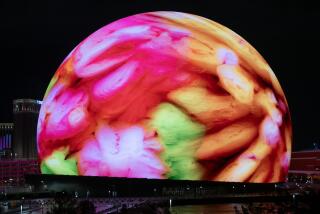Sculptor has engineered an artistic marvel
- Share via
LONDON -- It is one of the world’s biggest sculptures -- an immense engineering feat that stretches twice the length of a Boeing 747 and soars 10 stories high.
Anish Kapoor’s futuristic creation “Marsyas,” unveiled last week in London’s Tate Modern art gallery, leaves visitors gawking at its sheer scale.
At 508 feet long and 115 feet high, the enormous structure, made from a single span of PVC (polyvinyl chloride) membrane pulled taut over three steel rings, dominates the gallery’s cathedral-size main hall.
“It will undoubtedly come to be seen as one of the most significant sculptures of this century,” said Donna de Salvo, Tate Modern’s curator.
The structure consists of three giant steel rings -- two wedged vertically at either end of the vast Turbine Hall, with a third suspended horizontally over a walkway in the center of the space.
The blood-red membrane forms a giant trumpet at each ring and tapers into a fluted tunnel that arches across the hall. The PVC is stretched so tight that it looks as solid as cast bronze. It is so large that it’s impossible to see the entire sculpture from any one position.
Kapoor, who began the project in January, says the membrane has a fleshy quality, “rather like a flayed skin.” The title of his creation refers to Marsyas, the satyr in Greek mythology, who was flayed alive by the god Apollo.
The Indian-born artist says the work has “a kind of intimacy” and is “womblike.”
“I chose this red because I wanted it to be an experience of a kind of interior,” he said, adding that he wanted to humanize the industrial feel of the Tate Modern, a former power station on the River Thames that opened as a gallery in 2000.
The Turner Award-winning artist worked on the project with the Arup engineering firm. It took up to 40 people working 10 hours a day for almost four weeks to build the sculpture.
“This is a notoriously difficult space,” said Kapoor, who was born in Bombay in 1954 and has lived in London since the 1970s. “It’s a big thing because it needs to be a big thing. One hopes that it’s a deep thing.”
“Marsyas” has captured the imagination of London art critics.
The Independent said it resembled a “trio of blood-red lilies or oversized sinews of the body.”
Richard Campbell-Johnston of the Times called it “simply magnificent.”
“The work is fascinating as a feat of engineering alone,” he added. “The laws of physics must have been pushed to all but breaking point.”
The Guardian’s art critic, Adrian Searle, however, was somewhat dismissive about the “world’s biggest tapeworm.”
“It manages something difficult -- to be at once stupid and unforgettable,” Searle wrote.
“Marsyas” will be on display, free of charge, until April.
More to Read
The biggest entertainment stories
Get our big stories about Hollywood, film, television, music, arts, culture and more right in your inbox as soon as they publish.
You may occasionally receive promotional content from the Los Angeles Times.








